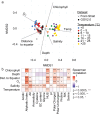Arctic Ocean virus communities and their seasonality, bipolarity, and prokaryotic associations
- PMID: 40645948
- PMCID: PMC12254263
- DOI: 10.1038/s41467-025-61568-6
Arctic Ocean virus communities and their seasonality, bipolarity, and prokaryotic associations
Abstract
Viruses of microbes play important roles in ocean environments as agents of mortality and genetic transfer, influencing ecology, evolution and biogeochemistry. However, we know little about the diversity, seasonality, and host interactions of viruses in polar waters. Here, we study dsDNA viruses in the Arctic Fram Strait across four years via 47 long-read metagenomes of the cellular size-fraction. Among 5662 vOTUs, 98% and 2% are Caudoviricetes and Megaviricetes, respectively. Viral coverage is, on average, 5-fold higher than cellular coverage, and 8-fold higher in summer. Viral community composition shows annual peaks in similarity and strongly correlates with prokaryotic community composition. Using network analysis, we identify putative virus-host interactions and six ecological modules associated with distinct environmental conditions. The network reveals putative novel cyanophages with time-lagged correlations to their hosts (in late summer) as well as diverse viruses correlated with Flavobacteriaceae, Pelagibacteraceae, and Nitrosopumilaceae. Via global metagenomes, we find that 42% of Fram Strait vOTUs peak in abundance in high latitude regions of both hemispheres, and encode proteins with biochemical signatures of cold adaptation. Our study reveals a rich diversity of polar viruses with pronounced seasonality, providing a foundation for understanding viral regulation and ecosystem impacts in changing polar oceans.
© 2025. The Author(s).
Conflict of interest statement
Competing interests: The authors declare no competing interests.
Figures








References
-
- Overland, J. et al. The urgency of Arctic change. Polar Sci.21, 6–13 (2019).
-
- Garneau, M.-È., Roy, S., Lovejoy, C., Gratton, Y. & Vincent, W. F. Seasonal dynamics of bacterial biomass and production in a coastal arctic ecosystem: Franklin Bay, western Canadian Arctic. J. Geophys. Res. C: Oceans113, C07S91 (2008).
MeSH terms
LinkOut - more resources
Full Text Sources

